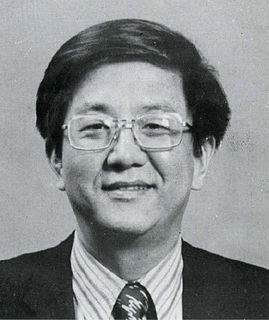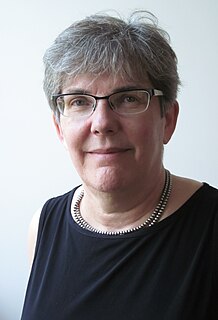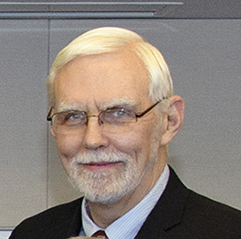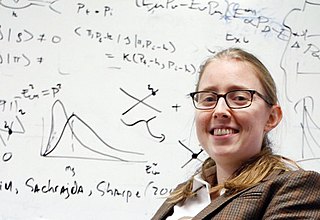Related Research Articles

David Jonathan Gross is an American theoretical physicist and string theorist. Along with Frank Wilczek and David Politzer, he was awarded the 2004 Nobel Prize in Physics for their discovery of asymptotic freedom. Gross is the Chancellor's Chair Professor of Theoretical Physics at the Kavli Institute for Theoretical Physics of the University of California, Santa Barbara (UCSB), and was formerly the KITP director and holder of their Frederick W. Gluck Chair in Theoretical Physics. He is also a faculty member in the UCSB Physics Department and is currently affiliated with the Institute for Quantum Studies at Chapman University in California. He is a foreign member of the Chinese Academy of Sciences.

In physics, lattice gauge theory is the study of gauge theories on a spacetime that has been discretized into a lattice.

Lattice QCD is a well-established non-perturbative approach to solving the quantum chromodynamics (QCD) theory of quarks and gluons. It is a lattice gauge theory formulated on a grid or lattice of points in space and time. When the size of the lattice is taken infinitely large and its sites infinitesimally close to each other, the continuum QCD is recovered.

Benjamin Whisoh Lee or Ben Lee, was a Korean-born American theoretical physicist. His work in theoretical particle physics exerted great influence on the development of the standard model in the late 20th century, especially on the renormalization of the electro-weak model and gauge theory.
The J. J. Sakurai Prize for Theoretical Particle Physics, is presented by the American Physical Society at its annual April Meeting, and honors outstanding achievement in particle physics theory. The prize consists of a monetary award, a certificate citing the contributions recognized by the award, and a travel allowance for the recipient to attend the presentation. The award is endowed by the family and friends of particle physicist J. J. Sakurai. The prize has been awarded annually since 1985.

Gerald Stanford "Gerry" Guralnik was the Chancellor’s Professor of Physics at Brown University. In 1964 he co-discovered the Higgs mechanism and Higgs boson with C. R. Hagen and Tom Kibble (GHK). As part of Physical Review Letters' 50th anniversary celebration, the journal recognized this discovery as one of the milestone papers in PRL history. While widely considered to have authored the most complete of the early papers on the Higgs theory, GHK were controversially not included in the 2013 Nobel Prize in Physics.

Richard Keith Ellis, is a British theoretical physicist, at the University of Durham and a leading authority on perturbative quantum chromodynamics and collider phenomenology.

Marcela Carena is a theoretical physicist at the Fermi National Accelerator Laboratory and a professor at the University of Chicago and the Enrico Fermi Institute. She is the Director of International Relations at Fermilab, as well as the head of the Theoretical Physics Department. As of January 1, 2016 she is the Chair Elect of the Division of Particles and Fields of the American Physical Society.
Louise Ann Dolan is an American mathematical physicist and professor of physics at the University of North Carolina at Chapel Hill. She does research in theoretical particle physics, gauge theories, gravity, and string theory, and is generally considered to be one of the foremost experts worldwide in this field. Her work is at the forefront of particle physics today.
Donald Henry Weingarten is a computational physicist.
Christine Tullis Hunter Davies is a professor of Physics at the University of Glasgow.
Michael John Creutz is an American theoretical physicist at Brookhaven National Laboratory specializing in lattice gauge theory and computational physics.

Heidi Marie Schellman is an American particle physicist at Oregon State University (OSU), where she heads the Department of Physics. She is an expert in Quantum chromodynamics.
Lillian Hartman Hoddeson is an American historian of science, specializing in the history of physics and technology during the 2nd half of the 20th century.

G. Peter Lepage is a Canadian American theoretical physicist and an academic administrator. He was the Harold Tanner Dean of the College of Arts and Sciences at Cornell University from 2003 to 2013.
John William Negele is an American theoretical nuclear physicist.

Phiala Elisabeth Shanahan is an Australian theoretical physicist who lives and works in the United States. She is known for her work on the structure and interactions of hadrons and nuclei and her innovative use of machine learning techniques in lattice quantum field theory calculations.
Anna Hasenfratz is a Hungarian-American theoretical high energy physicist whose research involves non-perturbative theories, especially in lattice quantum chromodynamics. She is a professor of physics at the University of Colorado Boulder.
Iain William Stewart is a Canadian-American theoretical nuclear and particle physicist, and a Professor at the Massachusetts Institute of Technology, where he is the current Director of the MIT Center for Theoretical Physics (CTP). He is best known for his work on effective field theories and for developing the Soft Collinear Effective Theory (SCET).
Aida Xenia El-Khadra is a particle physicist who is a Professor of High Energy Physics at the University of Illinois at Urbana–Champaign. She is the co-Chair of the Muon g-2 Theory Initiative, which reported hints at new physics in the Standard Model in 2021. She is a Fellow of the American Physical Society and the Alfred P. Sloan Foundation.
References
- ↑ "Shigemitsu, Junko 1949-", WorldCat Identities, retrieved 2021-01-17
- 1 2 "Fellows nominated in 2000 by the Division of Particles and Fields", APS Fellows archive, American Physical Society, retrieved 2021-01-17
- 1 2 "Junko Shigemitsu, Physics", Office of research, Ohio State University, retrieved 2021-01-17
- 1 2 Mackenzie, Paul (12 November 2014), Ben Lee Fellow Junko Shigemitsu discusses lattice QCD at today's colloquium, Fermilab, retrieved 2021-01-17
- 1 2 3 "Prof. Junko Shigemitsu", Physics people, Ohio State University, retrieved 2021-01-17
- 1 2 Curriculum vitae (PDF), Ohio State University, retrieved 2021-01-17
- ↑ "Junko Shigemitsu", Physics tree, retrieved 2021-01-17